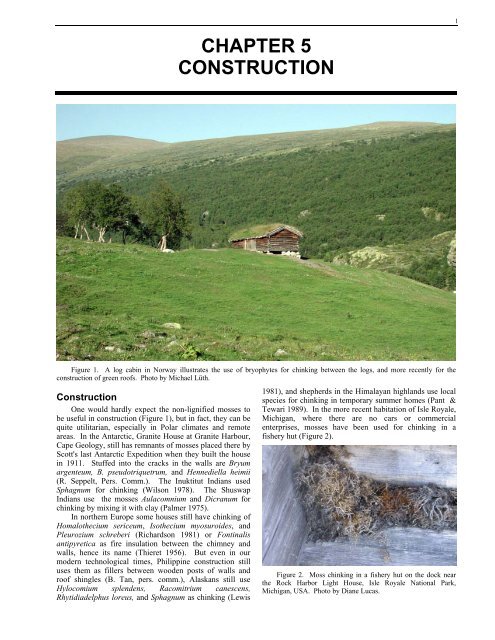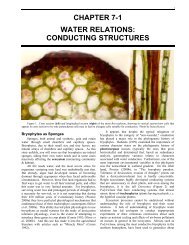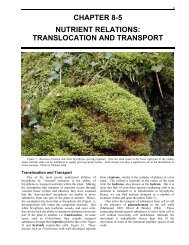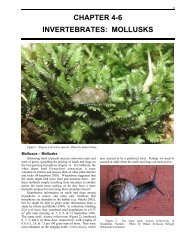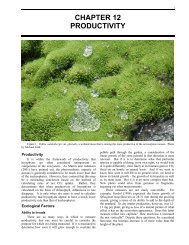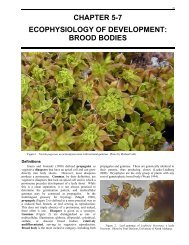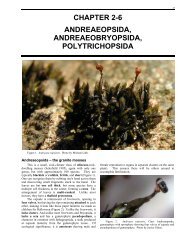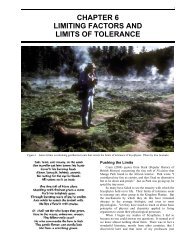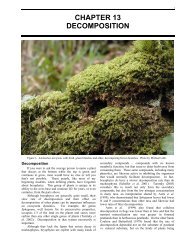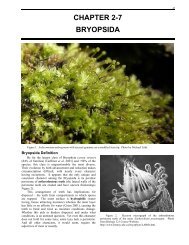Chapter 5: Construction - Bryophyte Ecology
Chapter 5: Construction - Bryophyte Ecology
Chapter 5: Construction - Bryophyte Ecology
Create successful ePaper yourself
Turn your PDF publications into a flip-book with our unique Google optimized e-Paper software.
CHAPTER 5<br />
CONSTRUCTION<br />
Figure 1. A log cabin in Norway illustrates the use of bryophytes for chinking between the logs, and more recently for the<br />
construction of green roofs. Photo by Michael Lüth.<br />
<strong>Construction</strong><br />
One would hardly expect the non-lignified mosses to<br />
be useful in construction (Figure 1), but in fact, they can be<br />
quite utilitarian, especially in Polar climates and remote<br />
areas. In the Antarctic, Granite House at Granite Harbour,<br />
Cape Geology, still has remnants of mosses placed there by<br />
Scott's last Antarctic Expedition when they built the house<br />
in 1911. Stuffed into the cracks in the walls are Bryum<br />
argenteum, B. pseudotriquetrum, and Hennediella heimii<br />
(R. Seppelt, Pers. Comm.). The Inuktitut Indians used<br />
Sphagnum for chinking (Wilson 1978). The Shuswap<br />
Indians use the mosses Aulacomnium and Dicranum for<br />
chinking by mixing it with clay (Palmer 1975).<br />
In northern Europe some houses still have chinking of<br />
Homalothecium sericeum, Isothecium myosuroides, and<br />
Pleurozium schreberi (Richardson 1981) or Fontinalis<br />
antipyretica as fire insulation between the chimney and<br />
walls, hence its name (Thieret 1956). But even in our<br />
modern technological times, Philippine construction still<br />
uses them as fillers between wooden posts of walls and<br />
roof shingles (B. Tan, pers. comm.), Alaskans still use<br />
Hylocomium splendens, Racomitrium canescens,<br />
Rhytidiadelphus loreus, and Sphagnum as chinking (Lewis<br />
1981), and shepherds in the Himalayan highlands use local<br />
species for chinking in temporary summer homes (Pant &<br />
Tewari 1989). In the more recent habitation of Isle Royale,<br />
Michigan, where there are no cars or commercial<br />
enterprises, mosses have been used for chinking in a<br />
fishery<br />
hut ( Figure 2).<br />
Figure 2. Moss chinking in a fishery hut on the dock near<br />
the Rock Harbor Light House, Isle Royale National Park,<br />
Michigan, USA. Photo by Diane Lucas.<br />
1
2<br />
For chinking, mosses are pressed between the logs<br />
with the fingers or an instrument and left to dry, where they<br />
remain compressed and still green. Use of peat for<br />
construction will be described in the Uses: Technological<br />
& Commercial chapter. In addition to construction, they<br />
are used to decorate and insulate buildings. For example,<br />
the City Hall in Iceland is decorated with mosses (Figure<br />
3).<br />
Figure 3. Moss wall decorating the Reykjavik City Hall in<br />
Iceland. Photos by Steffi Wilberscheid.<br />
Unfortunately, mosses used on the sides of buildings<br />
do not always meet the aesthetic goal we would hope for.<br />
In Munich, Germany, a huge tufa stone wall of an<br />
insurance building was covered with mosses (J.-P. Frahm,<br />
personal communication). However, eventually the<br />
mosses, so carefully cultivated on the rock (Figure 4), were<br />
washed off. The contractor, Michel Chiaffredo, blamed<br />
this on the heavy metal pollution and especially the copper<br />
that mosses accumulated before dying (Michel Chiaffredo,<br />
personal communication 2007). The water used for the<br />
irrigation was the water retrieved from roofs, then stored in<br />
a tank. The quantity of copper and other heavy metals in<br />
these mosses, indicated by the analysis conducted by the<br />
Pasteur Institute, killed the Aloina ambigua used for the<br />
green wall (Figure 5). Unfortunately, nobody wanted to<br />
assume the responsibility for the copper sulfate and other<br />
metals. Aloina ambigua is well adapted to a calcareous<br />
tufa, but it is not a copper moss. A new gardener tried to<br />
<strong>Chapter</strong> 5: <strong>Construction</strong><br />
replace the lost mosses with Brachythecium rutabulum,<br />
installing an expensive system to wet the stone, but this<br />
water dissolved the carbonates of the tufa rock, which then<br />
crystallized on the mosses and killed them (J.-P. Frahm,<br />
personal communication 2007). It appears that the new<br />
gardener did not understand the ecology of the moss – or<br />
the rock.<br />
Paths<br />
Older walkways around buildings were often<br />
constructed of bricks. Mosses eventually filled in the<br />
spaces between the bricks, adding a rustic and restful look.<br />
Vivian (1996) proclaims the need for such walkways,<br />
criticizing the sterile, formal appearance of straight<br />
concrete or blacktop. Such mosses seem to be a frequent<br />
subject for poets. See the subchapter on Uses: Literature.<br />
Figure 4. These mosses are being cultured on tufa to be used<br />
in building construction. Photo by Michel Chiaffredo.<br />
Figure 5. Aloina ambigua grows here on tufa rock such as<br />
that used for the insurance building in Munich. Photo by Michel<br />
Chiaffredo.
Ecocity<br />
Use of mosses to control erosion (Conard 1935; Figure<br />
6), muffle traffic noise, and retain cooling moisture forms<br />
the basis of a modern philosophy that may be labelled<br />
"ecocity." It follows the premise that mosses form a<br />
natural part of the ecosystem and that they have an<br />
important role in that ecosystem that can make life more<br />
pleasant for the human species, as well as maintaining a<br />
healthier ecosystem.<br />
At Ilsong (Ilsong 2004), in Korea, mosses are being<br />
touted for their ability to stabilize and beautify the<br />
environment in an environmentally friendly way. The<br />
Codra system starts with a soil embankment, such as one<br />
would find along a highway, and covers it with a layer of<br />
concrete formed like a rock outcrop, i.e., not flat, but with<br />
undulations like rocks. To this, mosses are added and<br />
eventually make a soothing green mat that catches water<br />
and helps to stabilize the bank. Presumably, even if the<br />
concrete develops cracks, the mosses will be able to fill in<br />
and maintain the stability. Mosses such as Hyophila<br />
(Figure 7) readily grow on such concrete coverings in<br />
Japan and presumably elsewhere that this moss occurs<br />
naturally. The moss catch system consists of blocks<br />
forming vertical walls that are covered with mosses. These<br />
systems require early maintenance that assures sufficient<br />
water until the moss system becomes established.<br />
Figure 6. Soil bank where mosses such as Polytrichum help<br />
to maintain stability. Photo by Janice Glime.<br />
Figure 7. The drought-tolerant, calciphilic moss, Hyophila<br />
involuta, grows easily on concrete. Photo by Michael Lüth.<br />
<strong>Chapter</strong> 5: <strong>Construction</strong><br />
Green Roofs<br />
I am a little disappointed when my friends risk life or<br />
limb on their roof, trying to remove mosses from the<br />
shingles. Although mosses have traditionally been<br />
considered a nuisance on roofs, with people spending<br />
hundreds of dollars to remove them, more recently they<br />
have made a new debut in Germany, the United States, and<br />
other places. Their new acclaim offers the advantage of<br />
cleaning the atmosphere of pollution while buffering the<br />
temperature, fireproofing, and creating a sound barrier. For<br />
more southern locations where slate roofs are common,<br />
they offer a lighter and cheaper alternative (Posth 1993).<br />
They are now being produced commercially in Germany<br />
(Behrens Systemtechnik) for roofing (Frahm 2004; Figure<br />
8). Interestingly, it is this German company that is<br />
installing moss roofs in Michigan, USA. However, most<br />
people still consider mosses on roofs a nuisance because<br />
they add weight and increase the growth of fungi, and<br />
many<br />
consider the roof to look dirty.<br />
Figure 8. Jan-Peter Frahm demonstrates a sheet of moss that<br />
is ready to be used in "green roof" construction. Photo by Jan-<br />
Peter Frahm.<br />
Michel Chiaffredo and Franck-Olivier Denayer (2004)<br />
treat the mosses as both aesthetically beautiful and<br />
ecologically sound additions to urban roofs (Figure 9;<br />
Figure 10). And they are getting customers in the "green<br />
roof revolution" who agree with them (Chiaffredo 2004).<br />
To quote them, "It is thus possible to set up on roofs, in one<br />
go, a combination of all the living elements that nature<br />
would introduce spontaneously over a far longer period of<br />
time: veil of micro-organisms associated with mosses, and<br />
wild seeds of dependent xerophilous plants. The natural<br />
environment thus reconstituted will evolve very slowly<br />
according to the ecological conditions of the site, requiring<br />
neither maintenance nor the introduction of fertilizers. This<br />
innovative phytoecological engineering makes it truly<br />
possible to maintain biodiversity, unlike all the agronomic<br />
or horticultural processes, even within the very heart of<br />
towns and cities." (Chiaffredo & Denayer 2004; Figure<br />
11).<br />
3
4<br />
Figure 9. This modern building has a green roof. Photo by<br />
Michel Chiaffredo.<br />
Figure 10. This green roof has bryophytes with skylights.<br />
Photo by Michel Chiaffredo.<br />
Figure 11. This bryophyte plantation prepares bryophytes<br />
for green roof construction. Photo by Jan-Peter Frahm.<br />
Chiaffredo and Denayer point out the advantages of<br />
using such vegetation on one's roof:<br />
• Regulate rainwater: Collection of water by<br />
rooftop vegetation, especially bryophytes, will<br />
prevent the movement of water from large<br />
surfaces onto a small area of ground below and<br />
permit the return of water slowly to the<br />
atmosphere by evapotranspiration.<br />
• Increase biodiversity: Opportunities for diversity<br />
in urban areas is limited, and rooftops add an<br />
opportunity for additional flora and fauna.<br />
<strong>Chapter</strong> 5: <strong>Construction</strong><br />
• Decrease the greenhouse effect: <strong>Bryophyte</strong>s are<br />
heat sinks that will cool by evapotranspiration on<br />
the one hand and retain heat by insulation in<br />
winter on the other, reducing the heat flux in and<br />
out of the building.<br />
• Improve air quality: <strong>Bryophyte</strong>s produce oxygen,<br />
use CO2, and trap dust particles, thus helping to<br />
clean the atmosphere.<br />
• Reduce sound pollution: Roofs can serve as<br />
sounding boards to bounce sounds, whereas the<br />
rough surface of a bryophyte mat absorbs sound,<br />
thus reducing the sound pollution of traffic or<br />
noisy equipment.<br />
When the roof is flat, the moss garden can be<br />
aesthetically pleasing as well (Figure 12). Mosses for<br />
green roof gardening can be grown in plantations (Figure<br />
11)<br />
where natural diversity develops (Figure 13).<br />
Figure 12. This completed green roof has a formal design,<br />
but many are more casual. Photo by Jan-Peter Frahm.<br />
Figure 13. This mat of mixed mosses is ready for<br />
transplantation to make a "green roof." Photo by Jan-Peter<br />
Frahm.<br />
In 2004, Bryonetters contributed their ideas to the<br />
species of mosses suitable for roofs. John Christy<br />
suggested that Ceratodon purpureus was a good candidate<br />
because of its ability to form sods on concrete, gravel,<br />
asphalt, and wood. It tolerates nitrogen, so air pollution<br />
and bird droppings would be less of a problem than for<br />
some mosses. Use of zinc-plated metal around roof vents,<br />
chimneys, skylights, and other objects must be avoided<br />
because they will kill the mosses. Spreading mosses by<br />
fragments will accelerate their establishment. Other weedy<br />
species such as the acrocarpous Bryum argenteum,
Tortula/Syntrichia, and Racomitrium will colonize the<br />
more exposed areas, whereas pleurocarpous taxa such as<br />
Mniaceae and Brachythecium will colonize shadier sites.<br />
Henk Greven suggested that Polytrichum formosum is<br />
easily transplanted and he would expect it to do well on<br />
roofs. Michel Chiaffredo has shown this to be the case<br />
(Figure 14; Figure 15).<br />
Controversies have arisen regarding the best upkeep<br />
for the green roof. Ideally, these roofs are low or no<br />
maintenance ecosystems. Thus, we would anticipate no<br />
need for fertilizers, which generally seem detrimental to<br />
bryophytes anyway. However, many of the roof gardens<br />
that have been in existence seem to be deteriorating<br />
(Koehler 2003), leading the roof gardeners to promoting<br />
fertilization. Chiaffredo and Denayer (2004) disagree with<br />
this approach, concluding that it is "contrary to the very<br />
definition of extensive vegetalization." The International<br />
Green Roof Association lists the moss-sedum-herbs and<br />
grasses community as a low maintenance, low cost green<br />
roof plant community (IGRA).<br />
Figure 14. These large mats of Polytrichum are ready for<br />
transplantation to a "green roof" site. Photo by Jan-Peter Frahm.<br />
The principle of the green roof for some companies<br />
relies on the well-known ability of mosses to colonize such<br />
a substrate with no help from us (Figure 16). At this stage,<br />
they are pioneers and require no watering or fertilizer<br />
(Figure 17). Diversity develops normally, hence providing<br />
stability (Figure 18). Their development can be compared<br />
to that of the cryptogamic crust that is so important in<br />
anchoring and nurturing the soil of prairies and semideserts<br />
in the North American Southwest, Israel, and parts of<br />
China and Australia. These crusts remove CO2 from the<br />
atmosphere, convert atmospheric N to ammonia and<br />
nitrates, and generally improve the quality of the habitat for<br />
invading organisms, while improving the air quality for<br />
humans.<br />
Using the studies on bryophytes as pioneers in these<br />
natural habitats as models, green roof landscapers have<br />
conducted studies on the best substrates for the roofs. The<br />
<strong>Chapter</strong> 5: <strong>Construction</strong><br />
most popular and successful roofing material is a mineral<br />
one of volcanic origin, having a granulometric variation of<br />
1-16 mm. Fentiman Consulting advocates a thin layer of<br />
concrete as a substrate for moss establishment (Grant<br />
2006).<br />
Figure 15. Polytrichum displays a marvelous collection of<br />
capsules with hairy caps in the background and numerous male<br />
splash cups in the foreground. Photo by Jan-Peter Frahm.<br />
Figure 16. Buildings in Norway with natural green roofs.<br />
Photo by Michael Lüth.<br />
Figure 17. Seashore damaged by tourists shows damaged<br />
bare sand area and restored area beyond the rope. Photo by<br />
Michel Chiaffredo.<br />
In London, England, the CUE Building of the<br />
Morniman Museum did not begin with bryophytes on its<br />
green roof (Grant 2006). However, successful<br />
5
6<br />
establishment of tracheophytes led to natural succession<br />
and invasion of native species, including bryophytes.<br />
Mosses became frequent in the more open areas, including<br />
Bryum capillare, Ceratodon purpureus, Hypnum<br />
cupressiforme, Pseudoscleropodium purum, and<br />
Brachythecium rutabulum. The wetter north-facing section<br />
sported, in addition to a number of grasses, a luxuriant<br />
growth of mosses made up of Rhytidiadelphus squarrosus,<br />
Brachythecium rutabulum, B. albicans, Kindbergia<br />
praelonga,<br />
and Calliergonella cuspidata.<br />
Figure 18. This restored area shows colonization by pioneer<br />
plants, including the bryophytes. Photos by Michel Chiaffredo.<br />
Sadly, it seems that using mosses for green roof<br />
construction has not become a common practice in the<br />
USA. Rather, xerophytic tracheophytes dominate<br />
greenroof landscaping there. But the idea has been planted,<br />
and ecologically minded green-roofers are considering the<br />
advantages in heat control vs. the disadvantages in<br />
introduction of pests, added weight, and moisture damage<br />
to roofing shingles.<br />
Grant (2006) sums up the green roof concept, stating<br />
"Green roofs are arguably the best example of<br />
multifunctional urban design, whereby elements on, in, and<br />
around the built environment serve several purposes. A<br />
roof (or external wall) can and should be more than just a<br />
weather-proof surface or structural element—it can be part<br />
of a living, cooling, cleansing skin that not only helps<br />
reduce flooding, urban heat-island effects, and air and noise<br />
pollution, but also provides wildlife habitat and<br />
tranquility." As proof of this utility, w have learned that at<br />
the Michigan Ford Rouge auto manufacturing plant, the<br />
green roof reduces power needs (Cesere 2006) through its<br />
function as a heat sink and evaporative cooling ability<br />
(Roofscapes 2004)!<br />
Eliminating Moss<br />
Unfortunately, not everyone shares the perception of<br />
the aesthetic appeal of mosses and liverworts. When they<br />
occur on roofs, and even in the cracks in the sidewalks,<br />
some people will declare war. I have been asked how to<br />
eliminate them on a roof, and my answer is "Why do you<br />
want to?" Of course on roofs they add weight, especially<br />
when wet, and can get in the way when shovelling heavy<br />
snow off during six months of winter, but still!<br />
Several bryocides seem to be successful. The one<br />
most familiar to me is lime (CaCO3), partly because most<br />
<strong>Chapter</strong> 5: <strong>Construction</strong><br />
bryophytes prefer more acid conditions, but perhaps even<br />
more important are the desiccating properties of lime.<br />
Bogdanov (1963) describes liming to eliminate mosses in<br />
forest stands (!) of drained swamps. A recent ad on the<br />
internet, however, seems to me a slightly better solution, if<br />
you must. This is a product called Moss Aside TM , an<br />
herbicidal soap (Gardens Alive). It will let you grow<br />
thicker lawns!<br />
Others advocate zinc or copper strips placed near the<br />
peak of the roof. Rainwater dissolves enough zinc to form<br />
zinc carbonate, which washes down the roof, killing the<br />
mosses. Of course, it accumulates on the ground below<br />
and will ultimately get into the water supply, so the<br />
solution can be a deadly one if many people begin this<br />
practice.<br />
One web site advocates using a standard scrub brush<br />
on a long handle to remove the moss. I cannot help but<br />
wonder if the brush doesn't do more damage to the asphalt<br />
than the moss does. And how practical is it for a roof like<br />
the one in Figure 20?<br />
Golf Courses<br />
In September 2006, Bryonet subscribers were asked to<br />
recommend the ideal moss for a golf course. Susan Moyle-<br />
Studlar (Bryonet, 14 September 2006) contributed several<br />
suggestions. She suggested Polytrichum species because<br />
they tolerate the high light levels of a golf course and are<br />
trampling resistant, being firmly anchored to the substrate.<br />
In fact, the trampling can help to propagate them by<br />
creating fragments that can produce new plants. They are<br />
common plants along trails and railroad tracks. However,<br />
she cautioned that they are a bit tall and will require<br />
frequent watering.<br />
A shorter and softer turf, relatively trampling resistant,<br />
is formed by Dicranella heteromalla (Figure 19) along<br />
forest trails, but she cautions that it is not well-anchored,<br />
possibly leading to a "choppy turf" following the activity of<br />
golfers. But, like Polytrichum species, these would also<br />
need watering and additionally would need shade.<br />
Figure 19. Dicranella heteromalla, known as green thread<br />
moss, grows here on a vertical bank. Photo by Michael Lüth.<br />
Leucobryum can tolerate trampling, as exhibited by its<br />
proliferation near a picnic shelter in West Virginia, USA.<br />
Moyle-Studlar considers this a possible candidate because<br />
of its tolerance of greater aridity than the former two, its<br />
retention of its attractiveness when dry, and its ability to<br />
reproduce from broken leaves. Nevertheless, the chopping
effect of golf clubs would most likely be quite destructive;<br />
hopefully winter would give it a chance to recover.<br />
Pleurocarpous mosses such as Hypnum imponens<br />
(Figure 21) and Thuidium delicatulum likewise seem to<br />
return from trampling damage, but they also pose the same<br />
problems of the above mosses and lack a secure anchoring<br />
system.<br />
Figure 20. This house in Bretagne has mosses invading the<br />
roof. Photo by Michael Lüth.<br />
Figure 21. Hypnum imponens appears here with H.<br />
jutlandica in the background. Photo by Michael Lüth).<br />
John Christy (Bryonet, 15 September 2006) reported<br />
seeing Bryum argenteum forming tightly-packed, extensive<br />
turfs growing among the closely clipped grass on golf<br />
greens on the west coast of North America. The moss<br />
seemed to grow well on the hard but well-drained surface.<br />
Diana Horton (Bryonet, 15 September 2006) reported the<br />
same species from a golf course in Arizona, where it<br />
<strong>Chapter</strong> 5: <strong>Construction</strong><br />
formed a "beautiful, short and dense sod." Only this time<br />
the manager wanted advice on how to eliminate it!<br />
In ruins near Abingdon, Great Britain, mosses were<br />
tucked between and behind the stones of a Roman well.<br />
Dickson (1981) concluded that the mosses were placed<br />
there deliberately because they were not the ones that one<br />
would expect there naturally. Hence, he suggested they<br />
might have been used to filter the water. One might expect<br />
them to help hold the rocks together as well.<br />
Building <strong>Construction</strong><br />
In the Philippines, one of the tallest mosses known,<br />
Spiridens reinwardtii, is used as a binding material (B. C.<br />
Tan, pers. comm.). It also serves as a filler between<br />
wooden posts and shingles in building the local huts.<br />
In Japan, mosses are used on walls, embankments, and<br />
roofs for both aesthetic purposes and practical ones<br />
(Deguchi, personal communication 2005). Deguchi has<br />
actually published in the Green Architecture Tribune 22: 8,<br />
a newsletter among the building industries in Japan,<br />
encouraging the use of bryophytes. Mosses not only give<br />
the building an "old" and quiet appearance, but they also<br />
reduce heat loss in winter and air conditioning needs in<br />
summer. Typical mosses for these purposes are Hypnum<br />
plumaeforme (Figure 22) and Racomitrium japonicum.<br />
Custom Stone Handlers, Squirrel Mountain Stone, in<br />
Tennessee, will provide choices of boulders with intact<br />
moss. It appears that most of these are intended for<br />
gardens, but they could be used in construction as well. A<br />
die-hard bryologist might even choose them for fireplace<br />
construction.<br />
Travertine Rock<br />
In calcareous waters, certain mosses are tufa formers<br />
(Crum 1973). The species Didymodon tophaceous makes<br />
such deposits, forming didymodontoliths! The tufa is<br />
formed by CaCO3 deposits on the moss surface as<br />
photosynthesis removes the CO2 from the water. These<br />
deposits result in a soft limestone that hardens into a porous<br />
brownish stone known as travertine. This elegantappearing<br />
travertine was once a common flooring material<br />
in many public buildings, especially banks. But its use was<br />
not just modern; the Roman Coliseum was built of<br />
travertine. This travertine rock, formed by the mosses, is<br />
not to be confused with the volcanic tufa that was a fragile<br />
rock also used by the Romans (Michel Chiaffredo, personal<br />
communication 2007).<br />
Problems in <strong>Construction</strong><br />
But mosses are not always welcome in construction.<br />
Not only are they considered a problem on roofs, but their<br />
moisture and organic acids contribute to the degradation of<br />
statues, tombstones, and walls (Perry 1987). On my own<br />
campus, student workers were instructed to spray them<br />
with herbicides in the cracks in the sidewalks because they<br />
made the walks look "unsightly." Fortunately, from my<br />
biased point of view, the mosses usually survive the<br />
herbicide treatments. And to my eyes, the mosses looked<br />
much better than the anthills that appeared in their absence!<br />
But, alas, this year they are being dug out. Obviously, our<br />
maintenance folks do not agree with Vivian (1996), or me!<br />
7
8<br />
Log Dams<br />
<strong>Bryophyte</strong>s can have advantages in emergencies<br />
because of their absorptive ability and small size. For<br />
example, when a temporary log dam developed a leak<br />
during a timber harvest in Japan, the resourceful workers<br />
used Hypnum plumaeforme (Figure 22), Loeskeobryum<br />
brevirostre, Rhytidiadelphus japonicus, and Thuidium<br />
kanedae to stop the leak (Ando 1957). And forest workers<br />
in Pennsylvania, USA, deliberately use rocks with<br />
Fontinalis on them to help stabilize newly constructed<br />
weirs. The mosses quickly spread to other rocks,<br />
effectively gluing them together.<br />
Figure 22. An epiphytic Hypnum plumaeforme is a moss<br />
among those used to repair a log dam in Japan and is also used on<br />
walls to give a cooling effect. Photo by Janice Glime.<br />
Boat <strong>Construction</strong><br />
Use of mosses in boat construction is well<br />
documented. In the Scottish Highlands, mosses were<br />
prepared by steeping in tar, then used for caulk (Crum<br />
1973; Figure 23). As in those used for houses, they were<br />
usually relatively large, pleurocarpous mosses such as<br />
Eurhynchium striatum and Neckera complanata (Pant &<br />
Tewari 1990). Mosses were even imported into Holland<br />
from Belgium after the 16th Century for caulking the<br />
carvel-built boats (Dickson 1973). And Polytrichum<br />
commune served for making the ropes (Figure 24). The<br />
online Deutsches Schiffahrtsmuseum (accessed on 20<br />
March at www.dsm.de/ MA/schlachte.htm) displays a rope<br />
made<br />
of this moss and carbon-dated to 1770.<br />
Figure 23. In this boat, mosses were used as rope caulk.<br />
Redrawn from Dickson (1973) by Janice Glime.<br />
<strong>Chapter</strong> 5: <strong>Construction</strong><br />
The native Yaghan people in Chile used mosses to<br />
build their canoes in quite a different way (Metzner<br />
Productions 2006). They buried tree bark in peat for a<br />
season, allowing the acidity to preserve the bark while the<br />
moisture made it flexible. They could then form it into a<br />
canoe.<br />
Figure 24. Polytrichum was used as rope caulk. Photo by<br />
Per Hoffmann.<br />
Summary<br />
In construction, mosses can provide chinking and<br />
even building material, as well as ameliorating the<br />
climate. Green Roof technology uses the process of<br />
natural succession to vegetate roofs and disturbed areas.<br />
Caution must be exercised in choosing bryophytes that<br />
are adapted to the type of substrate being used. On golf<br />
courses, bryophytes require no mowing and withstand<br />
at least some trampling. <strong>Bryophyte</strong> ropes have been<br />
used to construct boats.<br />
Acknowledgments<br />
Thank you to Steffi Wilberscheid for taking pictures of<br />
the Reykjavik City Hall for me while she was in Iceland,<br />
and to Jan-Peter Frahm for making contact with Steffi for<br />
me.<br />
Literature Cited<br />
Ando, H. 1957. Notes on useful bryophytes. Bull. Biol. Soc.<br />
Hiroshima Univ. 7(2): 23-26.<br />
Bogdanov, P. L. 1963. Liming as a method of combating mosses<br />
in forest stands on moss-covered felled areas and drained<br />
swamps. In: The Increase of Productivity of Swamped<br />
Forests, Israel Program for Scientific Translations,<br />
Jerusalem 49: 116-124.<br />
Cesere, A. 2006. A blueprint for green roofs. Michigan Daily<br />
Oct. 23. Accessed 28 May 2007 at<br />
.<br />
Chiaffredo, M. K. 2004. When mosses recreate the landscape on<br />
the roof. Greenroofs.com. In the news, February 2004.<br />
.<br />
Chiaffredo, M. K. and Denayer, F.-O. 2004. Mosses, a necessary<br />
step for perennial plant dynamics. MCK Environnement,<br />
France.
Conard, H. S. 1935. Mosses and soil erosion. Iowa State Coll. J.<br />
Sci. 9: 347-351.<br />
Crum, H. 1973. Mosses of the Great Lakes Forest.<br />
Contributions from the University of Michigan Herbarium<br />
10: 404 pp.<br />
Deutsches Schiffahrtsmuseum. Accessed on 20 March at<br />
.<br />
Dickson, J. H. 1973. <strong>Bryophyte</strong>s of the Pleistocene. The British<br />
record and its chorological and ecological implications.<br />
Cambridge University Press. pp. 192-195.<br />
Dickson, J. H. 1981. Bryological Notes: Mosses from a Roman<br />
well at Abingdon. J. Bryol. 11: 559-562.<br />
Frahm, J.-P. 2004. New frontiers in bryology and lichenology:<br />
Recent developments of commercial products from<br />
bryophytes. Bryologist 107: 277-283.<br />
Gardens Alive. Accessed on 26 May at<br />
.<br />
Grant, G. 2006. Extensive green roofs in London. Urban<br />
Habitats Dec. 2006, accessed on 28 May 2007 at<br />
<br />
Ilsong. 2004. Accessed on 9 June 2007 at<br />
.<br />
IGRA. International Green Roof Association. Accessed on 9<br />
June 2007 at .<br />
Koehler, M. 2003. Plant survival research and biodiversity:<br />
lessons from Europe – Greening Rooftops for Sustainable<br />
Communities: Chicago 2003.<br />
<strong>Chapter</strong> 5: <strong>Construction</strong><br />
Lewis, M. 1981. Human uses of bryophytes I. Use of mosses for<br />
chinking log structures in Alaska. Bryologist 84: 571-572.<br />
Metzner Productions. 2006. Pulse of the Planet. Accessed on 26<br />
May 2007 at<br />
.<br />
Palmer, G. 1975. Shuswap Indian Ethnobotany. Syesis 8: 29-51.<br />
Pant, G. and S. D. Tewari. 1989. Various human uses of<br />
bryophytes in the Kumaun region of Northwest Himalaya.<br />
Bryologist 92: 120-122.<br />
Pant, G. and S. D. Tewari. 1990. <strong>Bryophyte</strong>s and mankind.<br />
Ethnobotany 2: 97-103.<br />
Perry, D. 1987. As cities crumble, plants may be at the root of it.<br />
Smithsonian 17(10): 72-78.<br />
Posth, M. A. 1993. Put a green engine on the roof. Calif.<br />
Builder, April/May: 20-21.<br />
Richardson, D. H. S. 1981. The Biology of Mosses. John Wiley<br />
& Sons, New York. xii + 220 pp.<br />
Roofscapes Inc. 2004. FAQ's. Accessed on 28 May 2007 at<br />
.<br />
Thieret, J. W. 1956. <strong>Bryophyte</strong>s as economic plants. Econ. Bot.<br />
10: 75-91.<br />
Vivian, J. 1996. Natural paths and walkways. Mother Earth<br />
News June/July 1996. Accessed 9 June 2007 at<br />
.<br />
Wilson, M. R. 1978. Notes on ethnobotany in Inuktitut. Western<br />
Can. J. Anthropol. 8: 180-196.<br />
9


